Unit - 1
Origin and Classification
- According to Dr. Terzaghi (1948) 'Soil mechanics or Geotechnique' is the application of laws of mechanics and hydraulics to engineering problems dealing with sediments and other unconsolidated accumulations of solid particles produced by the mechanical and chemical disintegration of rocks regardless of whether or not they contain an admixture of organic constituents.
- Thus, one can say that soil mechanics or geotechnique is a branch of civil engineering that deals with application of principles of mechanics, hydraulics, chemistry to engineering problems related to soil.
- For example, in foundation, the structure ultimately rests on soil and the bearing capacity of the soil plays an important part of foundation design and knowledge is also useful in construction of earth dams, ground water movement, seepage, slope stability, bank protection, well hydraulics etc.
Classification of Soils:
- The purpose of soil classification is to arrange various types of soil into groups according to their engineering characteristics. For any classification system to be useful to engineers, it must fulfil the following three requirements:
- It should be simple to understand.
- It must have a limited number of groups.
- It must be based on the engineering properties which are relevant for the purpose.
Particle Size Classification System:

Fig: 1
- Soils are arranged according to grain sizes.
- Terms such as gravel, sand, silt size and clay size are used to indicate or designate the particle sizes, but do not signify naturally occurring soil types since the naturally occurring soil is a mixture of particles of varying sizes.
- Please note that the fine grained particles are classified as silt size and clay size and not as silt and clay. Use of simply silt and clay indicates properties of plasticity and cohesion over a wide range of water content. However, clay size or silt size particles may not exhibit these properties. For example, rock flour is not plastic in nature but has particles of the size of clay particles.
- Therefore, this classification system may be apt for coarse-grained soils but can be misleading for fine-grained soils.
- Some of the classification systems based on particle-size are:
a) MIT System
b) International Classification System
c) U.S. Bureau of Soil Classification
d) Indian Standard (I.S.)Classification System
Textural Classification System
- Texture refers to the visual appearance of the material. It depends upon particle size, shape of the particles and their gradation.
- However, the Textural Classification System is the soil classification of composite soils based exclusively on Particle Size Distribution.
- The most popular and acceptable Textural Classification System is the triangular classification system suggested by U.S. Bureau of Public Roads.
- According to this, particles are classified as sand (0.05-2mm), silt (0.005-0.05mm) and clay (< 0.005mm). The percentage of sand, silt and clay are plotted along the 3 sides of an equilateral triangle, which is further divided into 10 zones, each indicating a type of soil.
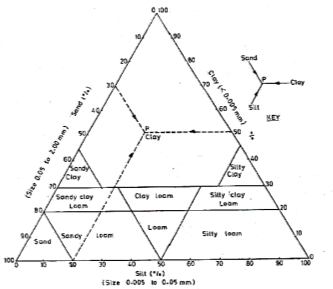
Fig: 2
- For example, the point ‘P’ in the figure denotes a soil that contains 30% sand, 20% silt and 50% clay. Hence, this soil is classified as clay.
AASHTO Soil Classification System
- American Association of State Highway and Transportation Official (AASHTO) Classification System classifies soil for use on highways, based on particle size distribution and plasticity characteristics.
- Both coarse-grained and fine-grained soil is classified into 8 groups: A1 to A7 with an additional group A8 for peat or muck. A1 and A7 are further sub-divided into 2 categories, while A2 is sub-divided into 4 categories.
- In general, the lower is the group number the more suitable is soil for highway construction.
- Soils within each group are evaluated according to a Group Index (GI) calculated as follows:
GI = 0.2a + 0.005ac + 0.01bd
Where, a = % passing through 75µ sieve greater than 35 but not exceeding 75 as a whole number (0 to 40)
b = % passing through 75µ sieve greater than 15 but not exceeding 55 as a whole number (0 to 40)
c = that portion of numerical liquid limit greater than 40 but not exceeding 60 as a whole number (0 to 20)
d = that portion of numerical plasticity index greater than 10 but not exceeding 30 as a whole number (0 to 20)
- Greater the value of GI, the less desirable is soil for highway construction within that sub-group.
- If GI < 0, it is reported as 0.
- If GI = 0-2: good sub-grade material
- If GI ≥ 2: poor sub-grade material
Unified Soil Classification System (USCS)
- USCS was first developed by A. Casagrande for the purpose of air-field construction during WW-II. However, it was later modified by Bureau of Reclamation and Corps of Engineers of USA to be applicable to dams, foundations etc.
- It is the most popular system. It classifies coarse-grained soils on the basis of their grain size distribution and the fine-grained particles on the basis of their plasticity characteristics. The symbols used for various soil types in USCS are shown in the table below.
| Symbols | Description |
Primary | G S M
C O Pt | Gravel Sand Slit (Symbol M obtained from the Swedis word ‘mo’) Clay Organic Peal |
Secondary | W P M C L H | Well-graded Poorly graded Non-plastic fines Plastic Fines Low plasticity High plasticity |
The soil is first classified into 3 categories:
- Coarse-grained soils: These are soils having 50% or more being retained on 0.075 mm sieve. They are further classified into 8 groups.
- These are termed as gravel (G) if 50% or more of coarse fraction is retained on 4.75 mm sieve otherwise it is called sand (S).
- Furthermore, if this soil contains less than 5% fines, which is well-graded (W), it is termed as GW or SW. However, if it is poorly graded (P), the soil is designated GP or SP.
- If the soil contains more than 12% fines, it may be designated as GM, GC, SM or SC where M stands for silt and C stands for clay.
- If fines are in the range of 5 to 12%, they may be termed as GW-GM, SP-SM etc.
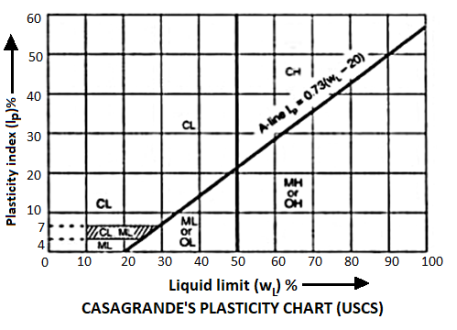
Fig: 3
2. Fine-grained soils: If 50% or more passes through 0.075 mm sieve, it is termed as fine-grained soil. They are further classified into 6 groups.
- These are further sub-divided into two types:
a) Soils of low compressibility (L) if liquid limit ≤ 50% and are designated the symbols ML, CL, OL. (O stands for organic)
b) Soils of high compressibility (H) if liquid limit > 50% and are designated the symbols MH, CH, OH.
- The exact type of soil is determined from the plasticity chart, in which the A-line separates the clays from the silts. The equation for A-line is as follows:
IP = 0.73 (wL – 20)
- If the value of IP ranged from 4 to 7, then dual symbols are used.
- When the soil is oven-dried and its liquid limit decreases by more than 30%, it is classified as organic (OL, OH). Otherwise, it is inorganic (ML, MH).
3. Highly organic soils: It is identified by visual inspection. It is also known as Peat (Pt).
Indian Standard Soil Classification System (ISSCS)
- It is based on USCS with the modification that fine-grained soils are sun-divided into 3 groups of low, medium and high compressibility, instead of 2 groups as in the case of USCS.
Low compressibility (L): LL < 35
Medium compressibility (I): 35 < LL < 50
High compressibility (H): LL > 50
- The soil is classified into 18 groups: 8 groups of coarse-grained, 9 groups of fine-grained and 1 group of Peat.
- The basic soil components as per ISSCS are as shown in the table below.
Soil | Soil components | Symbol | Particle size range and description |
(i)Coarse- grained components | Boulder
Cobble
Gravel
Sand | None
None
G
S | Rounded to angular, bulky, hard , rock, particle, average diameter more than 300 mm Rounded to angular, bulky, hard, rock particle, average diameter smaller than 300 mm but retained on 80 mm IS sieve. Rounded to angular, bulky, hard, rock particle, passing 80 mm IS sieve but retained on 4.75mm IS sieve Coarse: 80mm to 20mm IS sieve Fine: 20mm to 4.75mm IS sieve Rounded to angular, bulky, hard, rock particle; passing 4.75 mm IS sieve, but retained on 75-micron sieve Coarse: 4.75 mm to 2.0 mm IS sieve Medium: 2.0 mm to 425 micron IS sieve Fine: 425-micron to 65-micron IS sieve
|
(ii)Fine-grained components | Silt
Clay
Organic matter | M
C
O | Particles smaller than 75 micron IS sieve, identified by behaviour, that is slightly plastic or non-plastic regardless of moisture and exhibits little or no strength when air-dried
Particles smaller than75 micron IS sieve : identified by behaviour that is, it can be made to exhibit plastic properties within a certain considerable strength when air dried.
Organic matter in various sizes and stages of decomposition. |
- In order to solve following problems in civil engineering, the knowledge of geotechnical ring is of importance.
- Thus, various applications of geo-technical engineering are as follows:
- Foundation design
- Pavement design
- Design of earth dam
- Earth retaining structure
- Design of embankments
- Design of underground structures
1. Foundation design:
- Bearing capacity is one of the most important property considered in foundation design as foundation is important element of all civil engineering structures
- The area of the foundation will depend upon bearing capacity of soil. If we increase area of foundation, the intensity of load i.e., compressive stress is within limit of the bearing capacity. Is the foundation will be safe and problem of settlement is solved.
- For every structure, building, bridge: highway, dam etc. Soil is ultimate foundation material which support any structure and proper functioning of any structure.
- Thus, one can say life of structure depends upon the foundation strong will be the foundation more will be the life of structure.
- So, it is therefore, necessary to have sound knowledge of soil, i.e., bearing capacity of soil, the pattern of stress distribution in the soil beneath the loaded area, the probable settlement of the foundation, effect of ground water and effect of vibration also its shrinkage and swelling etc.
2. Pavement Design:
- A pavement may be of any type rigid or flexile, its performance depends upon the subsoil on which it rests.
- The thickness of pavement depends upon certain properties of sub soil, which should be determined before the design is made.
- Also, while designing the pavement various points related with soil like frost, heave a thaw with their related problems of frost damage to pavements, frost penetration depth, remedial measures to prevent it, problem of pumping and suitability of soil as a construction material for constructing highways, railways etc. should be decided.
3. Design of Earth Dam
- Soil is the only material required for the construction of earth dam thus thorough knowledge of soil mechanics is required.
- Since various types of soil is used in the construction of the earth dam, it is necessary to determine the soils properties, index properties such density, plasticity characteristics and specific gravity, particle size distribution and gradation of the soil, permeability, consolidation and compaction characteristics and shear strength parameter under various drainage condition.
4. Earth Retaining Structure:
- The example of earth retaining strictures are gravity retaining wall, anchored bulk heads and cofferdams.
- The active and passive earth pressures and the safe critical heights of an open cut form the important properties in the design of earth retaining wall.
- Permeability of the soil retained behind the wall is also important for the drainage of the retained earth.
- Thus, knowledge of soil structure interaction is essential to design properly the retaining structures subjected to soil loadings.
5. Design of Embankments:
- A thorough knowledge of shear-strength and related properties of soil is essential to design the slope and height of the embankment and cutting.
- The shear strength of soil reduces due to the seepage of water, thus while excavating this factor must be taken into account.
- Thus, knowledge of soil mechanics is important in design of embankments and excavation to face above situation and problems like seepage, caving in etc. and also action to increase the soil strength and to reduce the seepage forces, action to drain the subsoil water etc.
6. Design of Underground Structures:
- The examples of underground structures include tunnels, underground buildings, drainage structures and pipelines.
- Thus, for design of such structure a thorough knowledge of soil structure interaction is essential as such structures are subjected to sail loading.
- Also, one must have knowledge of stearing strength, angle of repose and frictional coefficient is essential and to solve problem such as seepage, caving in etc. and also to improve the properties of soil to increase shear strength and reduce seepage.
- Thus, from above examples it is clear that the soil mechanics is important in various field of construction.
Key Takeaways:
Thus, various applications of geo-technical engineering are as follows:
- Foundation design
- Pavement design
- Design of earth dam
- Earth retaining structure
- Design of embankments
- Design of underground structures
- Soils are formed by weathering of rocks due to mechanical disintegration or chemical decomposition.
- Soils are obtained from the geologic cycle that occurs in nature consisting of erosion, transportation, deposition and upheaval of soil from one place to another, by different agents such as wind, water, air etc.

Fig: 4
- There are two main groups of soil according to their origin:
Soil formed by physical weathering – gravel and sand
Physical processes include temperature changes, wedging action of ice, spreading of roots of plants and abrasion by different agents.
Soil formed by chemical weathering – silt and clay
Chemical processes include hydration, carbonation, oxidation and hydrolysis.
- If the products of rock weathering are still located at their place of origin, they are called residual or sedentary soils.
- Any soil that has been transported from its place of origin by wind, water, ice or any other agents and has been re-deposited at another location is known as transported soil.
Key Takeaways:
Soils are formed by weathering of rocks due to mechanical disintegration or chemical decomposition.
Transport:
- When any soil which is transported from its place of origin by wind, water, ice or any other agent and then redeposited, then it is called as transported soils.
Types of Transported Soil:
- Transported soils are further classified according to the transporting agency like wind, water, ice etc. and method of deposition.
- Alluvial soils: When the all type of soils is carried and deposited by water, then it is termed as alluvial soils.
- Aeolian soils: When the soil get deposited by wind, then it is termed as an Aeolian soil.
- Lacustrine soils: When soil particles caried by flowing water and deposited in lake, then such soils is termed as lacustrine soils.
- Glacial soils: Glacial soil is also termed as drift and drift is a general term used for the deposits made by glaciers. Soils which is mixed with the ice and are transported far away from their original position. Glaciers carry with them sous ranging from the fine grained to huge boulders.
- Peat: A fibrous aggregate of finer fragments of decayed vegetable matter is called as peat. It is very compressible and should be careful while using for supporting foundation of the structure.
- Bentonite: When the clay consists of a very high percentage of clay mineral montmorillonite, then it is called as bentonite. It is a highly plastic soil, and highly water absorbent and high shrinkage and swelling characteristics. Bentonite is a chemically weathered volcanic ash.
- Humus: A dark brown, organic amorphous earth of the top soil is termed as humus. It consist of partly decomposed vegetable matter and not suitable for engineering works
- Glacial soils: Glacial soil is also termed as drift and drift is a general term used for the deposits made by glaciers. Soils which is mixed with the ice and are transported far away from their original position. Glaciers carry with them soils ranging from the fine grained to huge boulders.
- Loess: When the size of soil particles range between 0.01 -0.05 mm, and air borne deposit characterized by a very uniform grain size and high void ratio, then it is called as loess. Its colour is yellowish light brown.
- Inorganic soils: When the soils formed by the accumulation of fragments of the inorganic skeleton or shells of organism, then it is called as inorganic soils.
- Colluvial soils: When the soils transported and deposited by gravity, then it is called as colluvial.
- Organic soils: When the soil formed by growth and subsequent decay of vegetable matter, then it is called as organic soils.
- Gumbo: It is sticky, plastic and dark-coloured clay.
Deposits:
Marin deposits
- Usually along the coast in narrow tidal plains marine clays are found. Marine clay may contain organic matter and also very soft clay.
- Marine clay has low shear strength and high compressibility.
- Because of above properties, such clay has problems to be used as construction material or as a foundation material.
Black cotton soil
- Black cotton soils are usually found in Maharashtra, Madhya Pradesh, Karnataka, Andhra Pradesh, Tamil Nada and Uttar Pradesh.
- Black cotton soil (Indian name) is also known as Expansive soils.
- In India they cover an area of approximately 3,00,500 Sq. Km. These soil is formed from basalt or trap.
- Black cotton soil is characterized by swelling and shrinkage because it contains clay mineral montmorillonite.
- As the volume of black cotton soil changes it is most susceptible to damage the light loaded structure.
- Under-reamed piles are considered most suitable as foundations for houses and other light structures constructed en such soil.
- These piles are taken to depths below the zone of seasonal variation in moisture content.
Laterites and lateritic soil
- These soils are usually found in Kerala, Karnataka, Maharashtra, Orissa and west Bengal.
- In India they cover an area of about 100,000 Sq. Km.
- The decomposition of rock, removal of the bases and silica and formation of oxides of iron and aluminium at the top of the soil profile are responsible for formation of laterites.
- Like all residual soils, laterites show variability in their properties, depending upon the stage of weathering.
Alluvial deposits
- Alluvial soils are formed in large parts of Northern India lying North of vindhyasatpura range in the Indo-Gangetic and Brahmaputra flood plains.
- The alluvial deposits extend from Assam in the East to Punjab in the west.
- The deposits have alternating layers of sand, silt and clay.
Desert soils
- Such soils are found in large parts of Rajasthan.
- They cover an area of about 500,000 sq.m.
- They are formed under highly arid conditions.
- Dune sand is a non-plastic uniformly graded, fine sand.
- Some of the problems associated with this soil are stabilization, settlement perviousness etc.
Boulder deposits
- Boulder deposits are found in the sub-Himalayan regions of Himachal Pradesh and Uttar Pradesh.
- River flowing in hilly terrains and near foot hills are responsible to deposit large quantities of boulders.
- The properties of these deposits depend on the relative proportions of the boulders and the soil matrix.
- These deposits have higher angles of shearing resistance.
Key Takeaways:
When any soil which is transported from its place of origin by wind, water, ice or any other agent and then redeposited, then it is called as transported soils.
- Soil composition is an essential thing of nutrient management. While soil minerals and natural be counted preserve and shop vitamins, soil water is what simply presents vitamins for plant uptake.
- Soil air, too, performs a crucial position seeing that most of the microorganisms that stay withinside the soil want air to go through the organic approaches that launch extra vitamins into the soil.
- The simple additives of soil are minerals, natural be counted, water and air. The usual soil includes about 45% mineral, 5% natural be counted, 20-30% water, and 20-30% air.
- These probabilities are best generalizations at best. In reality, the soil may be very complicated and dynamic. The composition of the soil can range on a day-by-day basis, relying on several elements inclusive of water supply, cultivation practices, and/or soil type.
- The stable section of soil, which incorporates minerals and natural be counted, are normally solid in nature. Yet, if natural be counted isn't well managed, it could be depleted from the soil.
- The liquid and fueloline levels of the soil, which can be water and air respectively, are the maximum dynamic residences of the soil. The relative quantities of water and air withinside the soil are continuously converting because the soil wets or dries.
Key Takeaways:
The simple additives of soil are minerals, natural be counted, water and air. The usual soil includes about 45% mineral, 5% natural be counted, 20-30% water, and 20-30% air.
A soil mass consists of solid particles forming a porous structure. The voids in the soil mass are filled with air and water. The three constituents are blended together to form a complex material.
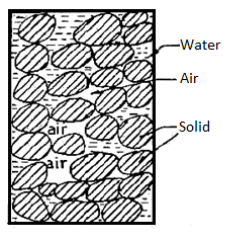
Fig: 5
A diagrammatic representation of different phases in a soil mass is called the Phase Diagram or the Block Diagram, for the purpose of making calculations convenient. In this all the 3 phases – solid, liquid and air – of the soil mass, are segregated and placed in 3 different layers.

Fig: 6
Usually, a 3-phase diagram is used, as shown in the figure below. As per convention, we write the volume on the left side and mass or weight on the right side of the diagram. Total volume is designated as V and it is equal to the sum of Volume of air (Va), Volume of water (Vw) and Volume of solids (Vs). Volume of voids (Vv) is the sum of volumes of air and water. Similarly, total mass is designated as M. Since the Mass of air (Ma) is very small, it is neglected. Therefore, total mass is the sum of Mass of water (Mw) and Mass of solids (Ms). Same convention is used for weights except it is designated by the letter W instead of letter M.

Fig: 7
However, sometimes, a 2-phase diagram may also be considered, as shown below. The convention as discussed above is applicable here also.
i) When the soil is absolutely dry, the water phase may disappear
Ii) When the soil is fully saturated, the air phase may disappear
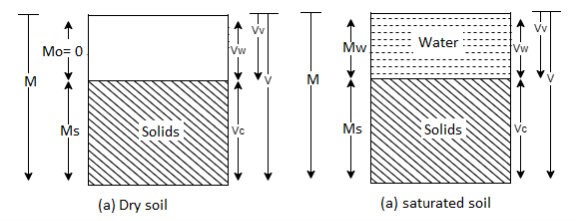
Fig: 8
- Water Content
w =  100
100
w ≥ 0 always
w = water content (%)
Ww = weight of water
Ws = weight of solids
2. Void Ratio
e = 
e > 0 always
e = void ratio
Vv = volume of voids
Vs = volume of solids
Void ratio of fine grained soils > Void ratio of coarse grained soils
3. Porosity
n =  100
100
0 < n < 100 always
n = porosity (%)
Vv = volume of voids
V = total volume of soil
4. Degree of Saturation
S =  100
100
0 ≤ S ≤ 100 always (S=0 for perfectly dry soil and S=100 for fully saturated soil)
S = degree of saturation (%)
Vw = volume of water
Vv = volume of voids
5. Air Content & Percentage Air Voids
ac =  100 = 1 - S
100 = 1 - S
0 ≤ ac ≤ 100
ac = air content (%)
Va = volume of air
Vv = volume of voids
na =  100
100
na = air voids (%)
Va = volume of air
V = total volume of soil mass
6. Unit Weight
a) Bulk Unit Weight: total weight per unit volume
Ƴ = 
Ƴ = bulk unit weight
W = total weight of soil mass = Wa + Ww
V = total volume of soil mass = Va + Vw + Vs
b) Dry Unit Weight: weight of soil solids per unit volume
Ƴd = 
Ƴd = bulk unit weight
Ws = total weight of soil solids
V = total volume of soil mass = Va + Vw + Vs
c) Saturated Unit Weight: weight of fully saturated soil sample per unit volume
Ƴsat = 
Ƴsat = saturated unit weight
Wsat = total weight of saturated soil mass
V = total volume of soil mass = Va + Vw + Vs
d) Submerged Unit Weight: weight of fully saturated soil sample per unit volume
Ƴsub = 
Ƴsub = submerged unit weight of solids = Ƴsat – Ƴwater ≈ Ƴsat/2
Wsat = total weight of saturated soil mass
V = total volume of soil mass = Va + Vw + Vs
7. Specific Gravity & Apparent/ Mass Specific Gravity
Specific gravity of soil solids (G) is the ratio of the unit weight of a given volume of solids to the unit weight of an equivalent volume of water at 4ᵒC.
G = 
Furthermore, apparent specific gravity (Gm) is the ratio of total weight of a given mass of soil to the weight of an equivalent volume of water.
Gm = 
Important Relationships:
- Relation between e and n
n =  and e =
and e = 
2. Relation between e, w, G and S
S e = w G
3. Bulk unit weight in terms of G, w, e and Ƴw
Ƴ =  =
= 
4. Saturated unit weight in terms of G, e and Ƴw
If soil is fully saturated, S = 1
Ƴsat = 
5. Dry unit weight in terms of G, e and Ƴw
If soil is dry, S = 0
Ƴd = 
6.Submerged unit weight in terms of G, e and Ƴw
Ƴsub = Ƴsat – Ƴwater
Ƴsub =  - Ƴw
- Ƴw
Ƴsub = 
7.Relation between Ƴ, Ƴd and w
Ƴd = 
- The soil mass in general is a three-phase system composed of soil, liquid and gaseous matter. The solid phase comprises of mineral, organic matter or both.
- The mineral portion consists of particles of different size and shapes.
- The organic fraction is the plant and animal residue which may be present in various stages of decomposition.
- The solids enclose the open spaces termed as voids. The liquid phase is generally water and fills partly or wholly the voids.
- The gaseous phase, usually air, occupies the voids not filled by water. The relative volume wise and weight wise proportions of the three phases in a soil mass are important factors influencing its physical properties.
- It is therefore necessary to study them. Though the three phases precut cannot be separated as shown in below Fig. For better understanding they are shown as occupying separate spaces.
- The diagrammatic representation of the different phase present in a soil mass is called the phase diagram.
- Fig. Shows a three-phase system of natural soil which is partially saturated soil.
- When it is fully saturated i.e., all the voids are filled with water and thus gaseous phase is absent and the soil becomes a two-phase system in fig.
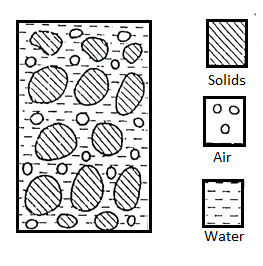
Fig 9: Natural soil
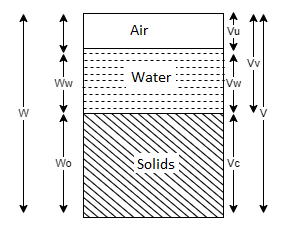
Fig 10: Partially saturated soil

Fig 11: Dry condition
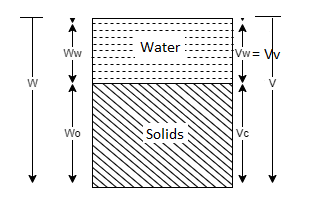
Fig 12: Saturated condition
- Also, if the soil becomes totally dry and consists of only solid and gaseous phases. In this case also it is a two-phase system.
Ww=Weight of water
Ws =weight of soils
V =total volume of soil mass
Va =volume of air
Vw =volume of water
Vv =volume of voids
Vs =volume of solids
- For Partially Saturated Condition,
Total weight, W=Ws+Ww+Wa
Wa=0
∴W=Ws+Ww
Total volume, V= Vs+Vv= Vs+Va+Vw (3 phase system)
- For dry condition,
W=Ws
V=Vs+Va (2 phase)
- For fully saturated soil,
W=Ws+Ww
V=Vs+Vw (2 phase)
Key Takeaways:
The soil mass in general is a three-phase system composed of soil, liquid and gaseous matter. The solid phase comprises of mineral, organic matter or both. The mineral portion consists of particles of different size and shapes. The organic fraction is the plant and animal residue which may be present in various stages of decomposition.
There are 3 most important corporations of clay minerals:
- Kaolinite - additionally consists of dickite and nacrite; fashioned through the decomposition of orthoclase feldspar (e.g. In granite); kaolin is the important constituent in china clay.
- Illite - additionally consists of glauconite (an inexperienced clay sand) and are the commonest clay minerals; fashioned through the decomposition of a few micas and feldspars; main in marine clays and shales.
- Montmorillonites - additionally consists of bentonite and vermiculite; fashioned through the alteration of mafic igneous rocks wealthy in Ca and Mg; weak linkage through cations (e.g. Na+, Ca++) outcomes in excessive swelling/shrinking potential.
Key Takeaways:
There are three types of clay minerals:
- Kaolinite
- Illite
- Montmorillonites
- Soil structure is the geometrical arrangement of soil particles with each other.
- Properties of soil such as permeability compressibility, shear strength etc. is greatly affected by soil structure.
- The following types of soil structure are generally recognized
- Single grained structure
- Honeycomb structure
- Flocculent structure
- Dispersed structure
- Composite structure
1. Single grained structure:
- When each panicle of soil scales out of suspension separately and independently then such soil structure is known as single grained structure.
- The gravitational forces acting on the particles of soil cases the settlement.
- The specific surface of all particles is comparatively less, thus the surface forces are too small to be considered.
- These surface forces are neglected for all practical purpose in case of course grained soils (Diameter> 0.02 m).
- Such soil particle has high void ratio when the deposits in a loose state and low void ration in a dense state.
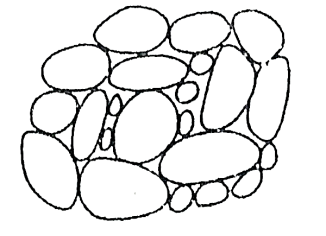
Fig 13: Single grained structure
2. Honeycomb structure:
- Honeycomb structure is seen in the soil particles having diameter between 0.0002-0.02 mm, usually observed in silts.
- In case of such soils, both gravitational forces and surface forces plays an important role.
- The soil particles settle due to gravitational forces and the surface forces at the contact area, are large enough compared to the submerged weighs to prevent the grains from rolling down immediately.
- The grains which are in contact are blend together until miniature arches are formed, with relatively large void space which is formed as honeycomb structure.
- In such type of structure comparatively large amount of water is enclosed within voids.
- Such type of structure has high voids ratio.

Fig 14: Honeycomb structure
3. Flocculent structure:
- Flocculent structure is formed when there is an edge contact between the clay platelets.
- The attractive electrical forces between adjacent soil particles at the time of deposition, is the basic reason for the formation of such type of structure.
- As the concentration of dissolved minerals is the water increases, the tendency of flocculation also increases.
- Flocculent structures are usually observed in clays with fine particles.
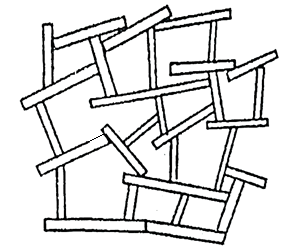
Fig 15: Flocculent structure
4. Dispersed structure:
- Dispersed structure is also seen in clays with fine particles.
- The repulsion electrical forces between adjacent soil particles at the time of deposition are responsible to form dispersed structure.
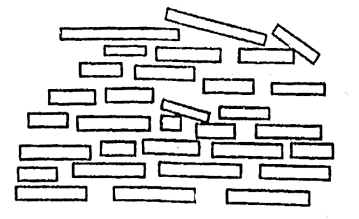
Fig 16: Dispersed structure
5. Composite Soil Structure:
- In case of composite soil following two structures can be found,
- Coarse grain skeleton
- Cohesive matrix
1.Coarse grain skeleton:
- When the void space between the single particles is filled with the clay particles; it is called as coarse grain skeleton.
- The bulky particles form a continuous relatively incompressible frame-work.
2.Cohesive matrix:
- When the clay content is more as compared with coarse particles; cohesive matrix is formed.
- Such type of soil formation is relatively more compressible.
Key Takeaways:
The following types of soil structure are generally recognized
- Single grained structure
- Honeycomb structure
- Flocculent structure
- Dispersed structure
- Composite structure
- The physical properties of soil which are useful to identify and distinguish soils from one another are called as index properties.
- The main index properties are: Particle size distribution, density index, consistency etc.
- The index property gives some information about the engineering properties.
- The index properties are sometimes divided into two:
1) Properties of soil mass
2) The properties of individual particle size.
1) Properties of soil mass:
- This property depends upon;
- The mode of soil formation.
- Soil history
- Soil structure.
- Such properties are usually determined by undisturbed samples or preferably from in-situ tests.
2) The properties of individual particle size:
- This property depends upon does not individual grains and depend on the mode of soil formation.
- Such properties are usually determined by disturbed samples.
Key Takeaways:
The main index properties are: Particle size distribution, density index, consistency etc. The index property gives some information about the engineering properties.
Sensitivity:
- The ratio of unconfined compressive strength of an undisturbed sample of soil to unconfined compressive strength of the remoulded sample of same soil at the same water content as in undisturbed soil is called as sensitivity (St)
St =
Where, qu=unconfined compressive strength of an undisturbed sample of soil or clay
qu’ = unconfined compressive strength of remoulded sample of soil or clay at the same water content as in the undisturbed soil.
- Sensitivity is a measure of the loss in strength of soils and remoulding on the consistency of a cohesive soil.
- Following table shows natural clay deposits classified into four different categories based on the value of sensitivity.
Sr.no | Sensitivity | Classification |
1 | 1-14 | Normal |
2 | 4-8 | Sensitive |
3 | 8-16 | Very sensitive |
4 | 16-32 | Slightly quick |
5 | 32-64 | Medium quick |
6 | Greater than 64 | Quick |
7 | Less than 1 | Stiff clay |
Table: Sensitivity classification soils
Thixotropy:
- Thixotropy is a Greek word in which thix means touch and tropo means change, overall meaning of thixtropy is any change which occurs by touch.
- Thixotropy is the property of certain clays or soil by virtue of it gradually regains its lost strength with time if remoulded clay is allowed to rest without change in water content.
- In short, if a remoulded soil sample having the sensitivity more than one is allowed to stand without change in water content and disturbance, then it may regain some parts of its original strength and stiffness. This increase in strength of soil sample is termed as thixotropy.
- Thixotropy has more practical importance in geotechnical engineering. In pile-driving operations, thixotropy plays important role. For example. There is a strength loss of soil, when a pile is diiron into the ground in such case, one can easily know regaining of shear strength after the pile has been driven and left in place for some time with the help of thixotropy.
Key Takeaways:
- The ratio of unconfined compressive strength of an undisturbed sample of soil to unconfined compressive strength of the remoulded sample of same soil at the same water content as in undisturbed soil is called as sensitivity (St).
- Thixotropy is a Greek word in which thix means touch and tropo means change, overall meaning of thixtropy is any change which occurs by touch.
The classification of soils according to the predominant or effective size is called the particle size classification.
The various terms used in this classification are as follows:
- Clay: less than 2

- Silt :2
 to 75 μ
to 75 μ - Sand: 75
 to 4.75 mm
to 4.75 mm - Gravel: 4.75 mm to 80 mm
- Pebbles: 80 mm to 300 mm
- Boulders: More than 300 mm
- The unified classification is based on the airfield classification system that was developed by A. Casagrande
- The system is based on both grain size and plasticity properties of the soil and is therefore, applicable to any use.
- The Indian Standard Institution (now Bureau of Indian Standards) adopted the unified classified system in 1954. The soil classification system 15 1498: 1970 is generally except for mine modification. Hence the salient features of Indian standards on the classification of soils are described below:
Table: Suffixes and prefixes
Soil type | Prefix | Subgroup | Suffix |
Gravel | G | Well graded | W |
Sand | S | Poorly graded | P |
Silt | M | Silty | M |
Clay | C | Clayey | C |
Organic | O | WL<35% | L |
|
| 35<WL<50 | I |
Peat | Pt | 50<WL | H |
Key Takeaways:
The unified classification is based on the airfield classification system that was developed by A. Casagrande. The system is based on both grain size and plasticity properties of the soil and is therefore, applicable to any use.
Numericals:
Q. The Void ratio and Specific gravity of sample of clay are 0.73 and 2.7 respectively. If the voids are 92% saturated find the bulk density, dry density and the water content?
Given:
e =0.73
G=2.7
S=92%
Find:
1)Water content(W)
W=
∴W =24.87%
2)Bulk density ( and dry density (
and dry density (



∴
Q. A Soil sample in its natural state has, when fully saturated, a water content of 32.5%. Determine the void ratio, dry density and saturated unit weights. Assume G=2.69.
Given:
w =32.5%
G=2.69
Find: Void ratio(e), Dry unit weights ( (
( )
)
We know,

For fully saturated S=1
e =w.G=
∴e =0.874
Dry unit weight 

For fully saturated soil S=1
∴e=



Q. A saturated clay has a water content of 40% and bulk specific gravity is 1.84. Determine the void ratio, and specific gravity of particles.
Given:
G=1.84
w=40%
e=
e=0.736
We know, n=
n=
n=0.424


∴G=0.78
Q. A saturated soil sample weighting 1.78 gm has a volume of 96cc.If G=2.67 determine the void ratio, water content and unit weight of the soil?
Given:
W=178gm
V=96cc
G=2.67
Find: e=?

18.19=

1+e=1.45
∴e= 1.45-1 =0.45
The grading curve of a soil gives the effective size as 0.16mm, Find Cu and Cc. Classify the soil.
Find Cu and Cc. Classify the soil.


Does not meet the requirement of well graded sand, given soil is poorly graded sand.
References:
- V.N.S Murthy-Soil Mechanics and Foundation Engineering (fifth Edition)
- K.R.Arora-Soil Mechanics and foundation Engineering
- Alam Singh- Modern Geotechnical Engineering
- C.Venkataramaiah-Geotechnical Engineering
- Gopal Ranjan and A.S.R. Rao-Basic and Applied soil mechanics